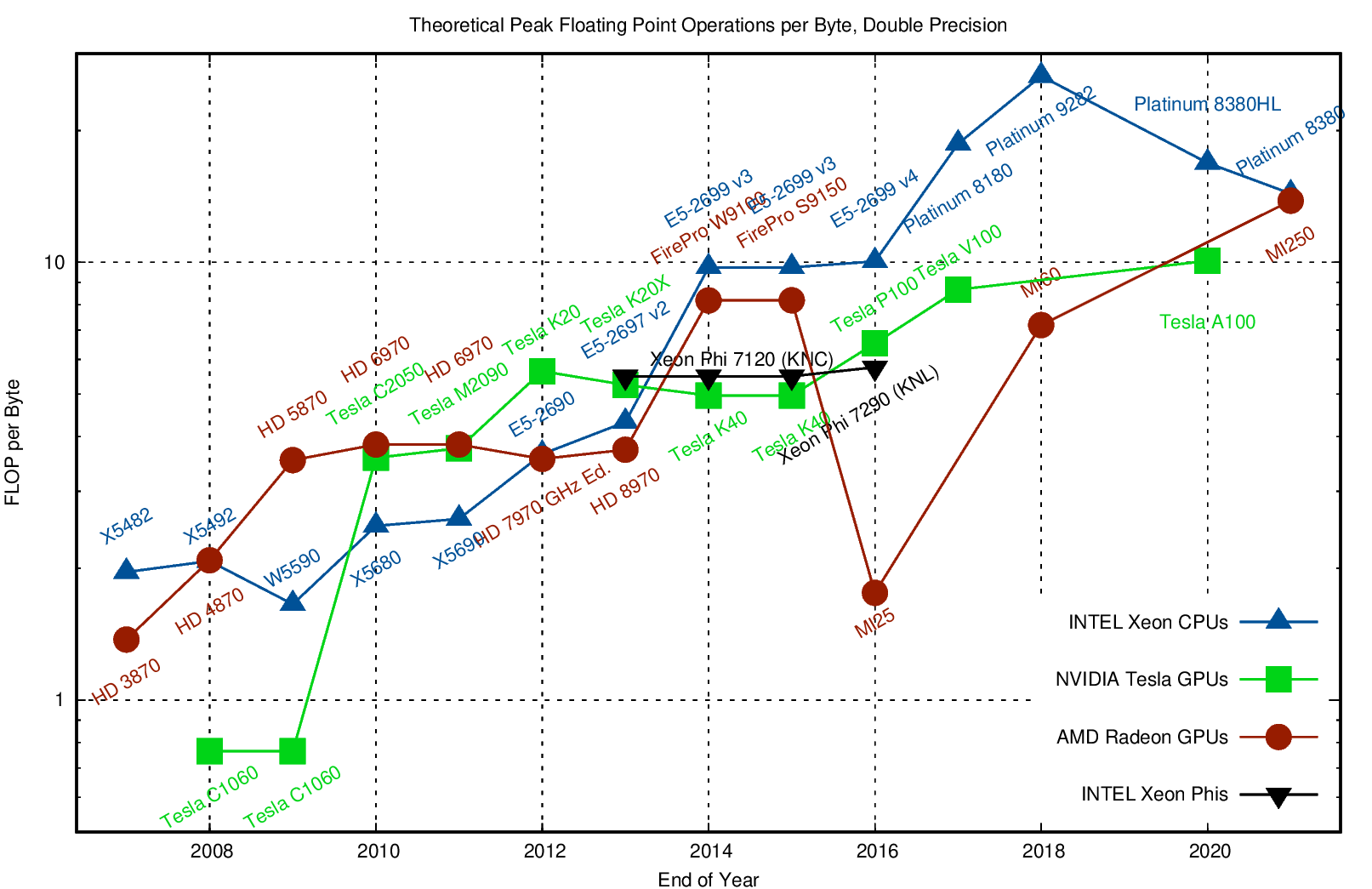2022-02-16 QR Stability
Contents
2022-02-16 QR Stability¶
Sahitya’s office hours: Friday 11-12:30
Last time¶
Gram-Schmidt process
QR factorization
Today¶
Stability and ill conditioning
Intro to performance modeling
Classical vs Modified Gram-Schmidt
Right vs left-looking algorithms
using LinearAlgebra
using Plots
using Polynomials
default(linewidth=4, legendfontsize=12)
function vander(x, k=nothing)
if isnothing(k)
k = length(x)
end
m = length(x)
V = ones(m, k)
for j in 2:k
V[:, j] = V[:, j-1] .* x
end
V
end
vander (generic function with 2 methods)
Gram-Schmidt orthogonalization¶
Suppose we’re given some vectors and want to find an orthogonal basis for their span.
A naive algorithm¶
function gram_schmidt_naive(A)
m, n = size(A)
Q = zeros(m, n)
R = zeros(n, n)
for j in 1:n
v = A[:,j]
for k in 1:j-1
r = Q[:,k]' * v
v -= Q[:,k] * r
R[k,j] = r
end
R[j,j] = norm(v)
Q[:,j] = v / R[j,j]
end
Q, R
end
gram_schmidt_naive (generic function with 1 method)
x = LinRange(-1, 1, 20)
A = vander(x, 20)
Q, R = gram_schmidt_naive(A)
@show norm(Q' * Q - I)
@show norm(Q * R - A);
norm(Q' * Q - I) = 1.073721107832196e-8
norm(Q * R - A) = 8.268821431611631e-16
What do orthogonal polynomials look like?¶
x = LinRange(-1, 1, 50)
A = vander(x, 6)
Q, R = gram_schmidt_naive(A)
plot(x, Q)
What happens if we use more than 50 values of \(x\)? Is there a continuous limit?
Solving equations using \(QR = A\)¶
If \(A x = b\) then \(Rx = Q^T b\). (Why is it easy to solve with \(R\)?)
x1 = [-0.9, 0.1, 0.5, 0.8] # points where we know values
y1 = [1, 2.4, -0.2, 1.3]
scatter(x1, y1)
A = vander(x1, 3)
Q, R = gram_schmidt_naive(A)
p = R \ (Q' * y1)
p = A \ y1
plot!(x, vander(x, 3) * p)
How accurate is it?¶
m = 10
x = LinRange(-1, 1, m)
A = vander(x)
Q, R = gram_schmidt_naive(A)
@show norm(Q' * Q - I)
@show norm(Q * R - A)
norm(Q' * Q - I) = 2.2794113434933815e-13
norm(Q * R - A) = 3.6437542961698333e-16
3.6437542961698333e-16
A variant with more parallelism¶
function gram_schmidt_classical(A)
m, n = size(A)
Q = zeros(m, n)
R = zeros(n, n)
for j in 1:n
v = A[:,j]
R[1:j-1,j] = Q[:,1:j-1]' * v
v -= Q[:,1:j-1] * R[1:j-1,j]
R[j,j] = norm(v)
Q[:,j] = v / R[j,j]
end
Q, R
end
gram_schmidt_classical (generic function with 1 method)
norm([0 1; 1 0])
1.4142135623730951
m = 10
x = LinRange(-1, 1, m)
A = vander(x, m)
Q, R = gram_schmidt_classical(A)
@show norm(Q' * Q - I)
@show norm(Q * R - A)
norm(Q' * Q - I) = 6.339875256299394e-11
norm(Q * R - A) = 1.217027619812654e-16
1.217027619812654e-16
Why does order of operations matter?¶
is not exact in finite arithmetic.
We can look at the size of what’s left over¶
We project out the components of our vectors in the directions of each \(q_j\).
x = LinRange(-1, 1, 20)
A = vander(x)
Q, R = gram_schmidt_classical(A)
scatter(diag(R), yscale=:log10)
The next vector is almost linearly dependent¶
x = LinRange(-1, 1, 20)
A = vander(x)
Q, _ = gram_schmidt_classical(A)
#Q, _ = qr(A)
v = A[:,end]
@show norm(v)
scatter(abs.(Q[:,1:end-1]' * v), yscale=:log10)
norm(v) = 1.4245900685395503
Cost of Gram-Schmidt?¶
We’ll count flops (addition, multiplication, division*)
Inner product \(\sum_{i=1}^m x_i y_i\)?
Vector “axpy”: \(y_i = a x_i + y_i\), \(i \in [1, 2, \dotsc, m]\).
Look at the inner loop:
for k in 1:j-1
r = Q[:,k]' * v
v -= Q[:,k] * r
R[k,j] = r
end

Counting flops is a bad model¶
We load a single entry (8 bytes) and do 2 flops (add + multiply). That’s an arithmetic intensity of 0.25 flops/byte.
Current hardware can do about 10 flops per byte, so our best algorithms will run at about 2% efficiency.
Need to focus on memory bandwidth, not flops.
Inherent data dependencies¶
Right-looking modified Gram-Schmidt¶
function gram_schmidt_modified(A)
m, n = size(A)
Q = copy(A)
R = zeros(n, n)
for j in 1:n
R[j,j] = norm(Q[:,j])
Q[:,j] /= R[j,j]
R[j,j+1:end] = Q[:,j]'*Q[:,j+1:end]
Q[:,j+1:end] -= Q[:,j]*R[j,j+1:end]'
end
Q, R
end
gram_schmidt_modified (generic function with 1 method)
m = 20
x = LinRange(-1, 1, m)
A = vander(x, m)
Q, R = gram_schmidt_modified(A)
@show norm(Q' * Q - I)
@show norm(Q * R - A)
norm(Q' * Q - I) = 8.486718528276085e-9
norm(Q * R - A) = 8.709998074379606e-16
8.709998074379606e-16
Classical versus modified?¶
Classical
Really unstable, orthogonality error of size \(1 \gg \epsilon_{\text{machine}}\)
Don’t need to know all the vectors in advance
Modified
Needs to be right-looking for efficiency
Less unstable, but orthogonality error \(10^{-9} \gg \epsilon_{\text{machine}}\)
m = 10
x = LinRange(-1, 1, m)
A = vander(x, m)
Q, R = qr(A)
@show norm(Q' * Q - I)
norm(Q' * Q - I) = 2.1776697623015113e-15
2.1776697623015113e-15
